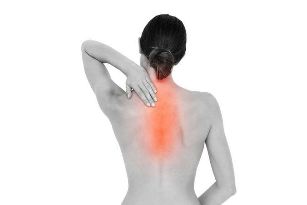
Osteochondrosis of the thoracic spine is often a pathology of the internal organs. Manifested by heart pain, shortness of breath, feeling of shortness of breath on inhalation and panic attacks. Therefore, the diagnosis of chest osteochondrosis is somewhat difficult. After detection, they perform conservative treatment with the help of drugs, physiotherapy, exercise. Severe damage to the chest plates and vertebrae requires surgery.
Brief description of the disease
Chest osteochondrosis is a degenerative-dystrophic disease of the spine. In the initial stages of its development, the intervertebral discs are slowly destroyed. They become thin and brittle, with radial cracks on their surface. To stabilize the chest segment affected by osteochondrosis, the bone tissue in the vertebrae grows with the development of acute growths - osteophytes. This will be the reason for the sharp restriction of mobility, the compression of the blood vessels and the roots of the spine.
Abnormal degrees
The degree of osteochondrosis is the sum of the symptoms characteristic of a particular radiographic stage. The more the discs and vertebrae are deformed, the more pronounced the clinical manifestations. The severity of the pathology always determines the tactics of treatment and should be considered when choosing drugs and their use.
Level I
X-rays ofusually show no changes. But the intervertebral disc had already begun to collapse because it was unable to retain the moisture needed to repair the tissues. Sometimes there is a little discomfort on your back that quickly disappears after a short rest. Grade 1 osteochondrosis is usually accidentally discovered in the diagnosis of other diseases.
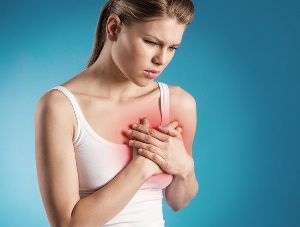
Grade II
The fibrous ring will be loose, fibrous. One of the cracks grows on the surface of the disc, the nucleus pulposus extending there. X-rays show a decrease in the distance between adjacent vertebral bodies due to a decrease in disc height. As a result of constant compensatory muscle tension, mobility in the chest region is limited, with moderate painful sensations.
Level III
The integrity of the annulus fibrosus is damaged, so the nucleus pulposus is displaced. A hernia is formed - the main cause of severe symptoms and serious complications of chest osteochondrosis. The vertebral bodies deform, a single osteophyte is formed. In the chest region, the pain becomes constant, the range of motion of the spine decreases significantly.
Level IV
X-rays ofclearly show the growth of connective tissues, the formation of more osteophytes. Adjacent vertebral bodies are blocked, fixed. Radical syndrome develops, discogenic myelopathy often occurs - due to spinal cord compression, with dangerous irreversible consequences. One hardly serves himself in everyday life, he loses the ability to perform professional tasks.
Causes of chest spinal osteochondrosis
Chest osteochondrosis in people over 40-45 years of age is caused by the natural aging of the body: recovery reactions are slowed down, collagen production is reduced, which causes the elasticity and strength of the ligaments. At a younger age, it occurs as a result of increased spinal stress or in the background of pathologies that already occur in the body:
- rheumatoid arthritis, systemic lupus erythematosus, scleroderma, ankylosing spondylitis;
- endocrine and metabolic diseases such as diabetes mellitus, gout, hypothyroidism, hyperthyroidism;
- congenital and acquired disorders, including kyphosis, scoliosis.
Previous spinal injuries, a sedentary lifestyle, and a lack of vitamins and trace elements in the body can cause premature disc death.
Typical signs and symptoms of the disease

Chest osteochondrosis develops gradually, first without showing up. There is a danger in this process. A person suffers from mild pain and discomfort due to banal muscle fatigue on his back after a hard day at work, housework or in the garden and does not seek medical help. Therefore, patients are usually diagnosed with a 2-3 degree pathology that is difficult to treat conservatively.
At the very beginning
During the exacerbation period, the pathology may present as pain between the shoulder blades, which occurs when the body is bent or turned. The range of motion decreases and there are several specific signs of relapse.
Chest pain
In osteochondrosis, chest pain first appears. They are not clearly localized, they can be given to the hands, collarbone, ribs. Heart pain is severe or moderate, resembles an attack of angina pectoris, and does not resolve with nitroglycerin. Sometimes they are similar to the feelings that occur during the exacerbation of cholecystitis, an inflammation of the pancreas. But unlike pancreatic or gallbladder lesions, pain is not accompanied by increased gas production, heartburn, and bloating.
Narrowing in the chest
Pain between the shoulder blades is sometimes accompanied by a feeling of lack of air when inhaled. A person is expected to be frightened, not understanding the reasons for this condition. Doctors recommend that you do not panic, but sit down and measure your heart rate. If the value obtained does not exceed 100 beats per minute, the probability of disturbing the lungs or heart is extremely low.
Other symptoms
Symptoms of osteochondrosis are gradually exacerbated by a hypersensitivity disorder. There are numbness, tingling, sliding creeps. From time to time, conditions similar to panic attacks occur. They are characterized by fear, increased heart rate, excessive sweating and cold sweating. If these symptoms are accompanied by chest pain, nitroglycerin should be taken and a doctor should be consulted. A similar syndrome may indicate a myocardial infarction.

The spinal roots in the chest region innervate the internal organs. When they become irritated, they compress, the work of the gastrointestinal tract and liver is upset. Peristalsis is confused with epigastric pain, heartburn, belching.
Signs in the subacute stage
After exacerbation, the subacute phase of thoracic osteochondrosis begins. Pain and breathing problems persist but are much less intense. For a long time, one does not look for a comfortable position of the body in which the pain is not felt. The duration of the subacute phase is up to two weeks. If all medical recommendations are followed, remission will occur, characterized by a lack of pronounced symptoms. Violation of the order leads to a new exacerbation of osteochondrosis.
Remission
During the remission phase, mild discomfort may occur if the weather changes or hypothermia occurs. Acute pain only occurs with 2-4 degrees of osteochondrosis due to excessive body rotation or tilt. Exacerbation of chronic pathologies, stress, increased physical activity, and prolonged stay in one position of the body can trigger another relapse.
Principles of diagnosing the disease
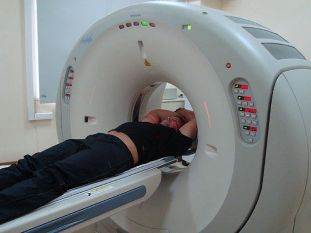
The neurologist makes a primary diagnosis based on the patient's complaints and medical history. An external examination reveals points in the chest region that are under pressure to cause pressure. Performing functional tests makes it possible to assess the safety of reflexes and identify sensitivity disorders. Of the instrumental methods, X-ray is the most informative. But for a detailed study of the spinal segment, CT, MRI can be performed. To rule out cardiovascular disease, patients receive an ECG.
First aid for aggravation
Pain during relapse of chest osteochondrosis is acute, pervasive, so first aid should be given. It should be soothed, laid on a hard surface, covered with a warm blanket. If the relapse is accompanied by increased heart rate, shortness of breath, increased anxiety, you should call a doctor. Any non-steroidal anti-inflammatory drug can be taken to relieve pain between the shoulder blades.
How to treat chest osteochondrosis
Only an integrated approach to treatment relieves all symptoms of osteochondrosis, slowing or completely stopping its spread to healthy discs and vertebrae. Conservative therapies with 1-2 degrees of pathology are used. In 3-4 degree osteochondrosis, the formation of large hernias is typical. Surgical treatment may be needed to relieve pressure on the blood vessels and the roots of the spine.
Preparations
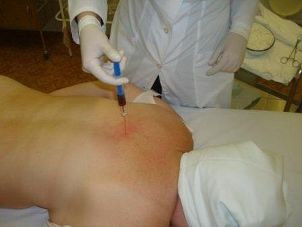
Medicines with different clinical and pharmacological groups are used in the treatment of chest osteochondrosis. In the initial stage, agents suitable for parenteral administration are generally used, which rapidly produce a therapeutic effect. A few days later, the injectable solutions are replaced with safer tablets, ointments and patches.
Non-steroidal anti-inflammatory drugs (NSAIDs)
NSAIDs have pronounced analgesic, anti-inflammatory and anti-edematous effects. Intramuscular administration of the solutions makes it possible to stop the acute pain. Topical application agents are used to eliminate mild discomfort between the shoulder blades. In the case of moderate pain, NSAIDs for oral administration perform well.
Muscle relaxants
Muscle relaxants are used to relieve muscle cramps in response to severe pain. Most often, treatment of thoracic osteochondrosis begins with the intramuscular administration of drugs that contain an anesthetic in addition to the muscle relaxant tolperisone.
Chondroprotectors
In the case of grade 1 pathology, the administration of a course of chondroprotectors will help to repair the damaged plates. In other cases, they are prescribed to improve metabolism in the affected segment of the spine to prevent the disease from progressing.
Vitamin B preparations
Their use helps to increase blood flow, improve the function of the peripheral nervous system, restore trophism and innervation. Vitamin B complex has a beneficial effect on degenerative disease of the nerves and musculoskeletal system.
Physiotherapy exercises
For 1 degree chest osteochondrosis, daily exercise therapy allows you to do it without medication. Healing is done by strengthening the muscles and improving the blood supply to the tissues with nutrients. In other cases, exercise and regular exercise help prevent healthy spinal segments from participating in the destructive process and prolong the remission phase.
From a complex standing position
In a standing position, the following therapeutic exercises are the most therapeutic:
- place your palm on your shoulder, lean forward as you lift your bent leg, as if trying to reach the opposite knee with your elbow;
- Raise your left hand, lean to the right. Perform the exercise in the opposite direction;
- Extend your shoulders to shoulder width, raise your arms. Lean forward, touching the opposite leg with the palm of your hand.
The number of repetitions is 10-12 times in 2-3 series.
From a predisposed situation
These exercises will require a gym mat or a thick, double-folded blanket:
- lie on your stomach while raising your arms and legs;
- Lie on your back, lift your upper body, stretch your palms to your feet;
- Lie on your back, bend one leg, wrap it around the other, and try to touch the floor with your knee.
Each exercise should be done 7-10 times.
Sitting
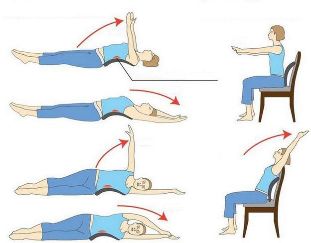
Sharp, high-amplitude movements, including twisting, should be avoided when performing such exercises:
- sitting on the floor, stretching forward, trying to touch the opposite leg with the palm of your hand;
- sitting on a chair or stool, extend your arms forward and slowly turn from side to side;
- Sitting on the floor, wrap your arms around your knees, pulling them as close to your chest as possible.
In the first lessons, the exercises are performed 5-7 times, approx. after one month - 15-20 times - should be repeated.
Physiotherapy
Magnetic therapy, laser therapy, UHF therapy, sinusoidal currents, shock wave therapy, paraffin and ozokerite applications are used to treat chest osteochondrosis. In case of aggravation, electrophoresis, ultrasonophoresis with glucocorticosteroids, anesthetics, B vitamins, chondroprotectors are performed.
Massage
A massage performed by a specialist helps to eliminate the pain between the shoulder blades and to relax the spasmodic skeletal muscles.
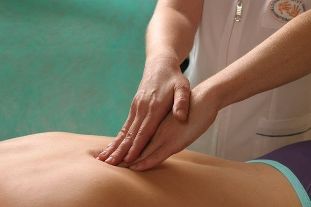
For osteochondrosis, all types of massage are therapeutically effective - classic, vacuum, acupuncture, connective tissue. At home, self-massage can be conveniently done with a wooden or electric long handle.
Acupuncture
Acupuncture is a method of treating pathology by inserting needles into bioactive points in the human body. They are thin and short, so there is occasional only a slight discomfort when piercing the skin. But even this effect is sufficient in the body to produce analgesic and anti-inflammatory substances.
Nutrition
Nutritionists recommend that patients with chest osteochondrosis give up fatty meats, rich soups, smoked meats, home and factory marinades. The amount of salt in the diet should be limited, which provokes the development of edema. Every day you need to drink about 2, 5 liters of fluid - water, vegetable juices, berry drinks, fruit compotes.
Folk remedies
Herbal decoctions and infusions, ointments, alcohol and oil rubs, and compresses are approved by neurologists after the main therapy. Folk remedies are sometimes used to relieve mild pain between the shoulder blades, which sometimes occur after physical exertion.
Celery root
Peel the large celery root, chop finely, squeeze the juice. Add 100 g of chopped fresh celery. Take 3 tablespoons up to 4 times daily with meals to cleanse the structure of the vertebrae from harmful salt deposits.
Sunflower root
Pour a teaspoon of dry, crushed sunflower root into a glass of hot water. Bring to the boil, simmer for 20 minutes, cool under a lid and drain. Drink 3-4 times a day.
Homemade Ointment
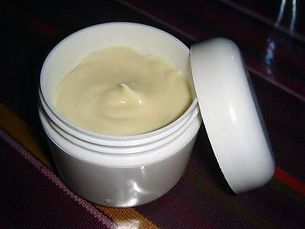
In a mortar, grind a tablespoon of turpentine gum and thick honey, add 2 drops of juniper, rosemary, eucalyptus essential oils. Inject 100 g of medical Vaseline in small doses. Stir, put in a bottle, store in the refrigerator, rub your back from the pain.
During pregnancy
Many systemic analgesics are contraindicated during pregnancy, so neurologists prefer drugs for external use - ointments, gels, patches. If you cannot do this without taking tablets, their dose will be significantly reduced. During the childbearing period, the main methods of therapy for chest osteochondrosis are massage and exercise.
Possible Consequences
In the absence of medical intervention, thoracic osteochondrosis can cause pneumosclerosis, arrhythmias, autonomic-vascular dystonia, gastrointestinal deterioration, and impaired sexual and reproductive function in women and men.
Prevention and prognosis
The prognosis is favorable with early detection of the disease and competent, complex treatment. If complications of thoracic osteochondrosis have developed, only adherence to all medical recommendations will allow stable remission to be achieved.
As a prophylaxis of pathology, neurologists recommend that provocative factors be excluded from the normal lifestyle. It is overweight, low physical activity, vitamin and mineral deficiency, excessive stress on the spine.













































